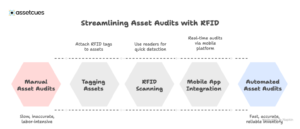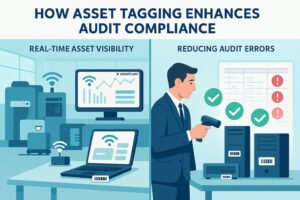Introduction
Enterprises lose an average of $70,000 annually due to poor asset tracking. Nearly 30% of fixed assets may be “ghost assets,” missing in reality. These discrepancies create audit issues, compliance risks, and financial losses for organizations. A fixed asset tagging system solves this by labeling and tracking assets centrally.
Dive into the latest best practices, technologies, and step-by-step advice for implementing robust asset tagging.
Each asset receives a scannable barcode or RFID tag for easy verification. This makes audits faster, more accurate, and far less stressful. Modern asset tagging processes ensure no asset is unaccounted for. Ultimately, streamlined verification improves compliance and strengthens overall financial control.
Understanding Fixed Asset Tagging Systems
What is a Fixed Asset Tagging System?
A fixed asset tagging system assigns physical identification tags to assets and manages them through software. Each asset receives a unique barcode or RFID chip linked to its register record. By scanning tags, companies instantly retrieve or update critical asset information. This process simplifies tracking, auditing, and day-to-day operational control significantly.
During audits, scanning tags quickly verifies an asset’s existence, location, and status. The system combines physical tags with a database, aligning financial and physical records. This clear definition also suits voice search and quick answers perfectly. Ultimately, tagging ensures audits remain efficient, accurate, and far less time-consuming.
Curious How Asset
Tagging Works ?
From Tag Placement - Tag Scanning - Real-Time Reporting
Curious How Asset
Tagging Works ?
From Tag Placement – Tag Scanning – Real-Time Reporting
Importance in Asset Management
Why does a fixed asset tagging system matter for finance and audit professionals? It delivers several key benefits in asset management:
-
Accuracy and Accountability:
Every asset is uniquely tagged and logged, dramatically improving record accuracy. Automated identification prevents human errors – no more guessing which asset is which. For example, tagging eliminates duplicate or “ghost” entries, so your fixed asset register mirrors reality.
-
Efficiency:
Tagging assets reduces audit time drastically, turning days into hours efficiently. Auditors can quickly scan items instead of manually recording serial numbers. Moreover, manual data entry in spreadsheets causes 88% error rates, slowing processes. Consequently, digital tagging makes organizations 30% less likely to face audit failures.
-
Compliance Confidence:
With a tagging system, meeting compliance and audit requirements becomes much easier. Regulators under IFRS and GAAP expect accurate and verified asset records. By scanning tags, companies instantly provide evidence of asset existence and location. Therefore, asset tagging ensures a reliable audit trail, supporting controls and financial audits.
Modern asset management solutions (like AssetCues) build these benefits in. For instance, AssetCues’ platform integrates asset tagging into its fixed asset register, giving finance managers real-time visibility and audit-ready records. By implementing a robust tagging system, you establish accuracy, efficiency, and compliance as standard features of your asset management process.
Asset Tagging Methods for Effective Audits
Not all asset tagging methods are equal, and therefore efficiency often varies. While barcodes and RFID both work, each impacts audit speed differently. Consequently, choosing the right system improves verification accuracy and reduces costly delays. Ultimately, effective equipment tagging makes audits faster, smoother, and far more reliable.
RFID Tool Tracking Explained
RFID tool tracking uses radio-frequency tags to monitor and audit assets. Each tag carries unique data and a transmitter, enabling instant detection nearby. Auditors can walk with readers and verify equipment without line-of-sight scanning. This drastically reduces manual labor while ensuring faster, more reliable inventory audits.
Unlike manual scanning, RFID instantly bulk-reads tags and identifies missing items. In workshops, it confirms tool availability quickly or detects misplaced equipment. This process boosts audit speed, accuracy, and convenience while reducing human errors. Therefore, organizations prefer RFID for valuable assets or large-volume equipment categories.
Even mobile apps now support RFID scanning, making audits seamless and real-time. For example, AssetCues enables both barcode and RFID scanning through its mobile platform. Companies deploying RFID ensure audit readiness with quick reader sweeps for full inventory. This guarantees efficiency, consistency, and complete verification whenever audit cycles begin.

Equipment Tagging System Benefits
An equipment tagging system (whether using barcodes, RFID, or QR codes) offers several concrete benefits that improve audit outcomes and overall asset management:
-
Improved Compliance:
Every asset receives a tag and digital record, simplifying compliance with standards. Auditors can instantly verify assets against the register, ensuring complete accuracy. Moreover, automated tagging enforces standardized data like ID, location, and ownership. As a result, compliance gaps shrink, unlike traditional manual asset management processes.
-
Enhanced Asset Visibility:
Research in ScienceDirect shows supply chains face disruptions, shifting demands, and compliance pressures. Therefore, real-time asset visibility becomes essential for accurate control and efficiency. Asset tagging enables this by tracking asset status, location, and ownership. Consequently, managers verify availability instantly, catch discrepancies early, and prevent costly audit surprises.
-
Reduced Audit Time & Errors:
Scanning tags is far faster and more reliable than manual verification methods. Auditors can complete tasks in hours with scanners instead of days manually. The system alerts teams about missing or unrecorded assets, reducing costly errors. In fact, one AssetCues client cut audit time by 70%, lowering overall costs.
RFID vs. Barcode (How they stack up for asset auditing)
To put these methods in perspective, here’s a comparison of two common tagging technologies – RFID vs. Barcode – and how they stack up for asset auditing:
Aspect |
RFID Tagging |
Barcode Tagging |
Scanning Method |
Uses radio waves; no line-of-sight needed. Can read multiple tags at once (bulk scan). | Uses optical reader; requires line-of-sight and one-by-one scanning. |
Speed & Efficiency |
Extremely fast – can scan hundreds of assets in seconds, ideal for large inventories. | Slower – each asset’s barcode must be scanned individually, which can be time-consuming for big audits. |
Data Capacity |
Can carry more data (some RFID tags can store asset info or sensor data). Tags can be read/write for updates. | Limited data (typically just an encoded ID or number in the barcode). Read-only; cannot update once printed. |
Cost per Tag/Reader |
Higher cost. RFID tags and readers are more expensive (readers ~10× the cost of barcode scanners). Best for high-value or high-volume assets where speed pays off. | Very low cost. Barcodes (paper labels or metal plates) are cheap and readers are inexpensive. Cost-effective for smaller asset pools. |
Durability |
Tags can be very durable (weather-proof, not easily damaged). Suitable for harsh environments (outdoors, industrial). | Barcodes can fade, scratch, or fall off over time, especially in harsh conditions, which can hinder scanning. |
Use Case Example |
Warehouses, data centers, or hospitals using RFID to rapidly audit equipment fleet without disrupting operations. | Offices, small businesses, or fixed installations using barcodes to tag computers, furniture, etc., on a tight budget. |
RFID offers speed and automation advantages, scanning many assets without line-of-sight. In contrast, barcodes remain simpler and cheaper for smaller-scale operations. Many organizations adopt hybrids, using RFID for critical assets and barcodes elsewhere. This balance delivers cost-efficiency while still ensuring reliable and effective tracking.
Modern platforms like AssetCues support both methods within a single integrated system. When combined with centralized tracking, either method significantly improves audit accuracy. Unlike manual checks, RFID and barcode scans instantly highlight missing assets. This capability streamlines audits and reduces compliance risks across varied environments.
While RFID costs more, it scans hundreds of tags in seconds. This speed becomes invaluable for large audits requiring rapid inventory counts. Meanwhile, barcodes provide a low-cost and dependable alternative, though requiring more labor. Ultimately, an equipment tagging system, RFID or barcode, makes audits highly effective.
How Asset Tagging Enhances Audit Compliance
Implementing an asset tagging system not only accelerates audits but also strengthens compliance. By keeping asset records accurate and verifiable, tagging supports key audit requirements. This directly reduces audit risk while aligning with finance team priorities. Below are two major ways asset tagging improves overall audit compliance.

Real-time Asset Visibility
One major compliance challenge is proving records match reality accurately. However, asset tagging provides real-time visibility across all assets. Each movement or service updates instantly, while IoT and RFID automate updates seamlessly.
This ensures your fixed asset register stays current and audit-ready at all times. For example, if equipment transfers to another site, its new location appears immediately. Tagging systems also generate alerts for missing or inactive assets. These safeguards allow teams to address issues before auditors discover them.
Platforms like AssetCues integrate tagging directly with ERP systems for seamless updates. Scanning 100 assets today updates the finance system immediately, avoiding reconciliations. This proves controls work continuously, not just during year-end audits. With continuous visibility, companies reduce risks and remain audit-ready year-round.
Reducing Audit Errors
Tagging systems significantly reduce errors during audits, lowering compliance risks considerably. Traditional audits involve manual counts, IDs, and reconciliations where mistakes creep in. Studies reveal error rates as high as 88% with spreadsheets. These errors cause mismatches, forcing auditors to investigate issues and raise findings.
Asset tagging eliminates manual errors by capturing exact IDs with every scan. Using barcodes or RFID, systems prevent typos, omissions, and inaccurate entries. They also reconcile scanned data with registers, flagging mismatches for correction. Furthermore, each scan records user, time, and action, ensuring a reliable audit trail.
External studies confirm the benefits: automated tracking cuts audit failures by 30%. Fewer errors mean smoother audits, greater credibility, and reduced penalties. Tagging also supports compliance assertions like asset existence, required under IFRS standards. By reducing surprises, asset tagging makes audits predictable, consistent, and truly stress-free.
Step-by-Step Guide to Implementing Asset Tagging for Audits
Implementing a fixed asset tagging system seems daunting, yet straightforward using steps. Moreover, this clear How-To guide helps deploy asset tagging effectively. Therefore, follow these steps to improve audit readiness and ensure smooth implementation.
By following these steps, you build a sustainable asset tagging program effectively. Structured as a HowTo, search engines recognize its step-by-step format. Each step ensures thorough execution, covering planning, tagging, integration, and ongoing audits. When implemented well, tagging delivers faster audits and consistently cleaner asset data.
FAQs
Q.What is fixed asset tagging?
A. Fixed asset tagging means labeling an organization’s long-term assets (fixed assets like machinery, computers, vehicles) with unique identification tags for tracking. Each fixed asset gets a durable tag (often with a barcode or RFID) that links to records of its location, value, and maintenance, aiding financial reporting and audits.
Q.How does asset tagging improve compliance during audits?
A. Asset tagging improves compliance by creating a clear, verifiable trail of every asset. When auditors can scan a tag and instantly match it to the register, it proves asset existence and ownership without manual guesswork. This transparency reduces audit findings and helps organizations meet IFRS, GAAP, and internal control standards.
Q.What is the process of asset verification in Tagging?
A. The process of asset verification involves physically checking assets against the fixed asset register to confirm their existence, location, and condition. Using tagging methods like barcodes or RFID, each asset is scanned and matched with system records. Discrepancies (such as missing, duplicate, or ghost assets) are flagged for correction, ensuring records remain accurate and audit-ready.

Ready to Tag Smarter?
Schedule a Free Demo with AssetCues – barcode printing, digital tracking, and effortless audits.
Ready to Tag Smarter?
Schedule a Free Demo with AssetCues – barcode printing, digital tracking, and effortless audits.

Conclusion & Call-to-Action
In conclusion, a fixed asset tagging system transforms how organizations manage audits effectively. By digitally tracking each asset, audits become simpler, more accurate, and compliant. No more missing items or messy spreadsheets—every asset stays recorded in one system. As a result, finance, audit, and operations benefit from reliable records and smoother processes.
Adopting AssetCues simplifies tagging system implementation while ensuring quick and effective deployment. Designed for finance and audit professionals, it covers tagging, tracking, and reporting seamlessly. The user-friendly system delivers fast results, driving high ROI from reduced errors. In fact, many companies see fewer discrepancies and gain 30% more audit efficiency.
Ready to streamline asset audits and achieve complete compliance with confidence? Request an AssetCues demo to see how tagging and verification simplify audits instantly. Our experts will show seamless integration, rapid deployment, and reliable financial reporting benefits. Contact us today for a free consultation and make your next audit hassle-free.
(By implementing a fixed asset tagging system now, you’ll be joining the ranks of forward-thinking Finance and Audit Managers who have turned a tedious audit process into a streamlined, tech-driven practice. It’s professional, it’s proven, and it’s ready to deliver results – let AssetCues help you make it a reality.)
About Author






